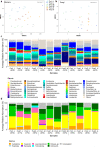Unchartered waters: the unintended impacts of residual chlorine on water quality and biofilms
- PMID: 32978404
- PMCID: PMC7519676
- DOI: 10.1038/s41522-020-00144-w
Unchartered waters: the unintended impacts of residual chlorine on water quality and biofilms
Erratum in
-
Author Correction: Uncharted waters: the unintended impacts of residual chlorine on water quality and biofilms.NPJ Biofilms Microbiomes. 2022 Jul 12;8(1):55. doi: 10.1038/s41522-022-00318-8. NPJ Biofilms Microbiomes. 2022. PMID: 35821221 Free PMC article. No abstract available.
Abstract
Disinfection residuals in drinking water protect water quality and public heath by limiting planktonic microbial regrowth during distribution. However, we do not consider the consequences and selective pressures of such residuals on the ubiquitous biofilms that persist on the vast internal surface area of drinking water distribution systems. Using a full scale experimental facility, integrated analyses were applied to determine the physical, chemical and biological impacts of different free chlorine regimes on biofilm characteristics (composition, structure and microbiome) and water quality. Unexpectedly, higher free chlorine concentrations resulted in greater water quality degredation, observable as elevated inorganic loading and greater discolouration (a major cause of water quality complaints and a mask for other failures). High-chlorine concentrations also reduced biofilm cell concentrations but selected for a distinct biofilm bacterial community and inorganic composition, presenting unique risks. The results challenge the assumption that a measurable free chlorine residual necessarily assures drinking water safety.
Conflict of interest statement
The authors declare no competing interests.
Figures





Similar articles
-
Chlorine and Monochloramine Disinfection of Legionella pneumophila Colonizing Copper and Polyvinyl Chloride Drinking Water Biofilms.Appl Environ Microbiol. 2019 Mar 22;85(7):e02956-18. doi: 10.1128/AEM.02956-18. Print 2019 Apr 1. Appl Environ Microbiol. 2019. PMID: 30683743 Free PMC article.
-
Impact of disinfection on drinking water biofilm bacterial community.J Environ Sci (China). 2015 Nov 1;37:200-5. doi: 10.1016/j.jes.2015.04.008. Epub 2015 Jun 26. J Environ Sci (China). 2015. PMID: 26574105
-
Multi-species biofilms defined from drinking water microorganisms provide increased protection against chlorine disinfection.Biofouling. 2013 Sep;29(8):917-28. doi: 10.1080/08927014.2013.816298. Epub 2013 Jul 24. Biofouling. 2013. PMID: 23879183
-
[Biofilms and Oxidizing Biocides; Evaluation of Disinfection and Removal Effects by Using Established Microbial Systems].Yakugaku Zasshi. 2017;137(6):707-717. doi: 10.1248/yakushi.16-00254. Yakugaku Zasshi. 2017. PMID: 28566577 Review. Japanese.
-
Heterotrophic bacteria in drinking water distribution system: a review.Environ Monit Assess. 2012 Oct;184(10):6087-137. doi: 10.1007/s10661-011-2407-x. Epub 2011 Nov 11. Environ Monit Assess. 2012. PMID: 22076103 Review.
Cited by
-
Characterization of Scale Deposits in a Drinking Water Network in a Semi-Arid Region.Int J Environ Res Public Health. 2022 Mar 10;19(6):3257. doi: 10.3390/ijerph19063257. Int J Environ Res Public Health. 2022. PMID: 35328945 Free PMC article.
-
Biofilms in Water Hoses of a Meat Processing Environment Harbor Complex Microbial Communities.Front Microbiol. 2022 Feb 14;13:832213. doi: 10.3389/fmicb.2022.832213. eCollection 2022. Front Microbiol. 2022. PMID: 35237250 Free PMC article.
-
Deep generative modeling of annotated bacterial biofilm images.NPJ Biofilms Microbiomes. 2025 Jan 14;11(1):16. doi: 10.1038/s41522-025-00647-4. NPJ Biofilms Microbiomes. 2025. PMID: 39809829 Free PMC article.
-
Non-invasive Biofouling Monitoring to Assess Drinking Water Distribution System Performance.Front Microbiol. 2021 Oct 28;12:730344. doi: 10.3389/fmicb.2021.730344. eCollection 2021. Front Microbiol. 2021. PMID: 34777279 Free PMC article.
-
Biofilm detachment significantly affects biological stability of drinking water during intermittent water supply in a pilot scale water distribution system.Sci Rep. 2025 Jul 1;15(1):22408. doi: 10.1038/s41598-025-03535-1. Sci Rep. 2025. PMID: 40594086 Free PMC article.
References
-
- Husband, S., Fish, K. E., Douterelo, I. & Boxall, J. Linking discolouration modelling and biofilm behaviour within drinking water distribution systems. Water Sci. Technol.Water Supply10.2166/ws.2016.045 (2016).
Publication types
MeSH terms
Substances
LinkOut - more resources
Full Text Sources
Medical

